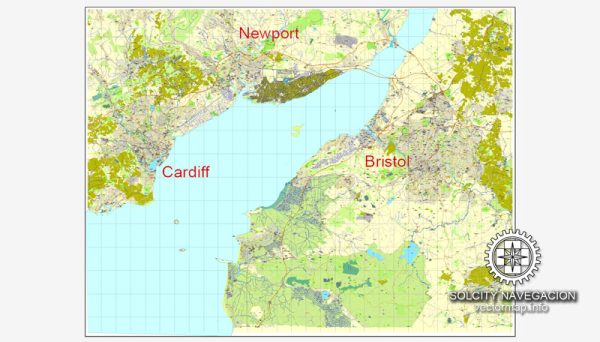Bristol, Cardiff, and Newport are all cities in the United Kingdom, each with its own unique economic history shaped by factors such as location, natural resources, trade, and industrial development.
Vectormap.Net provide you with the most accurate and up-to-date vector maps in Adobe Illustrator, PDF and other formats, designed for editing and printing. Please read the vector map descriptions carefully.
- Bristol:
- Medieval and Renaissance Periods (11th to 17th centuries): Bristol has a long history as a port city, dating back to the medieval period. During this time, it was a major center for trade, particularly in wool and textiles. The city’s location along the River Avon made it a crucial hub for commerce.
- 18th and 19th Centuries: Bristol played a significant role in the transatlantic slave trade during the 18th century. The city’s economy prospered from the trade of goods such as tobacco, sugar, and slaves. However, the slave trade was eventually abolished in the early 19th century, leading to a shift in Bristol’s economic focus.
- Industrialization: Bristol became an important industrial center in the 19th century, with the development of industries like shipbuilding, engineering, and manufacturing. The port continued to be a crucial part of Bristol’s economy, facilitating the import and export of goods.
- 20th Century: Bristol’s economy diversified in the 20th century, with the growth of industries such as aerospace, electronics, and financial services. The city’s economy became more service-oriented, and it established itself as a center for technology and innovation.
- Cardiff:
- Coal and Iron Industry (18th to 19th centuries): Cardiff’s economic history is closely tied to the development of the coal and iron industry. The city became a major coal-exporting port, and the expansion of the industry led to significant economic growth. The construction of railways further facilitated the transportation of coal.
- 20th Century: Cardiff’s economic landscape underwent transformation in the 20th century. The decline of the coal industry led to diversification, and the city became a hub for industries such as steel manufacturing, shipping, and finance.
- Post-World War II: Cardiff continued to evolve as a center for finance and services. The development of the Cardiff Bay area in the late 20th century marked a significant urban regeneration project, transforming former docklands into a vibrant waterfront area.
- Newport:
- 19th Century Industrialization: Newport, like Cardiff, experienced significant industrialization during the 19th century. The city became a crucial hub for the iron and steel industry, with large-scale production and exportation.
- Coal and Steel Industry: Similar to Cardiff, Newport’s economy was heavily dependent on coal and steel. The port facilitated the export of these products, contributing to the city’s economic prosperity.
- Decline and Regeneration: In the latter half of the 20th century, Newport faced economic challenges due to the decline of traditional industries. However, efforts at urban regeneration and diversification into sectors like technology and services have aimed to revitalize the city’s economy.
In summary, the economic histories of Bristol, Cardiff, and Newport are marked by their roles as major ports and industrial centers. Over time, they have adapted to changing economic landscapes, diversifying into new industries to sustain growth and development. Urban regeneration projects have also played a significant role in shaping the modern economic profiles of these cities.


 Author: Kirill Shrayber, Ph.D.
Author: Kirill Shrayber, Ph.D.